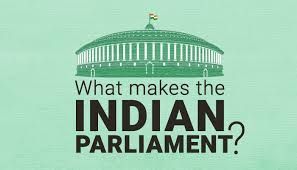The Indian Parliament.
May 22, 2019 • 15 views

TheParliament of Indiais the supremelegislative bodyof theRepublic of India.
It is abicamerallegislaturecomposed of thePresident of Indiaand the two houses: theRajya Sabha(Council of States) and theLok Sabha(House of the People).
“Bicameral legislature: Bicameral legislatureis alegislativesystem having two-tier of Assemblies, Chambers or Houses.”
Legislative proposals are brought before either house of the Parliament in the form of a bill. A bill is the draft of a legislative proposal, which, when passed by both houses of Parliament and assented to by thePresident, becomes anAct of Parliament.

The President in his role as head of legislature has full powers to summon and prorogue either house of Parliament or to dissolve Lok Sabha. The president can exercise these powers only upon the advice of thePrime Ministerand hisUnion Council of Ministers.
ThePresident of India, thehead of state, is a component of Parliament. UnderArticle 60andArticle 111, the President's responsibility is to ensure that laws passed by the Parliament are in accordance with the constitutional mandate and that the stipulated procedure is followed.
ThePrime Minister of Indiais thehead of governmentand exercises mostexecutive power. Appointed by the president, the prime minister is by convention supported by thepartyorpolitical alliancehaving a majority of seats in the Lok Sabha or lower house of parliament.

Lok Sabha(House of the People) or thelower househas 545members. 543 members are directly elected by citizens of India on the basis ofuniversal adult franchiserepresentingParliamentary constituenciesacross the country and 2 members are appointed by thePresident of India.
Rajya Sabha(Council of States) or theupper houseis a permanent body not subject to dissolution. One third of the members retire every second year, and are replaced by newly elected members. Each member is elected for a term of six years.Its members are indirectly elected by members of legislative bodies of the states. The Rajya Sabha can have a maximum of 250 members.
The period during which the House meets to conduct its business is called a session. TheConstitutionempowers the President to summon each House at such intervals that there should not be more than a six-month gap between the two sessions. Hence the Parliament must meet at least twice a year. In India, the Parliament conducts three sessions each year:
·Budget session: February to May.
·Monsoon session: July to September.
·Winter session: November to December.
